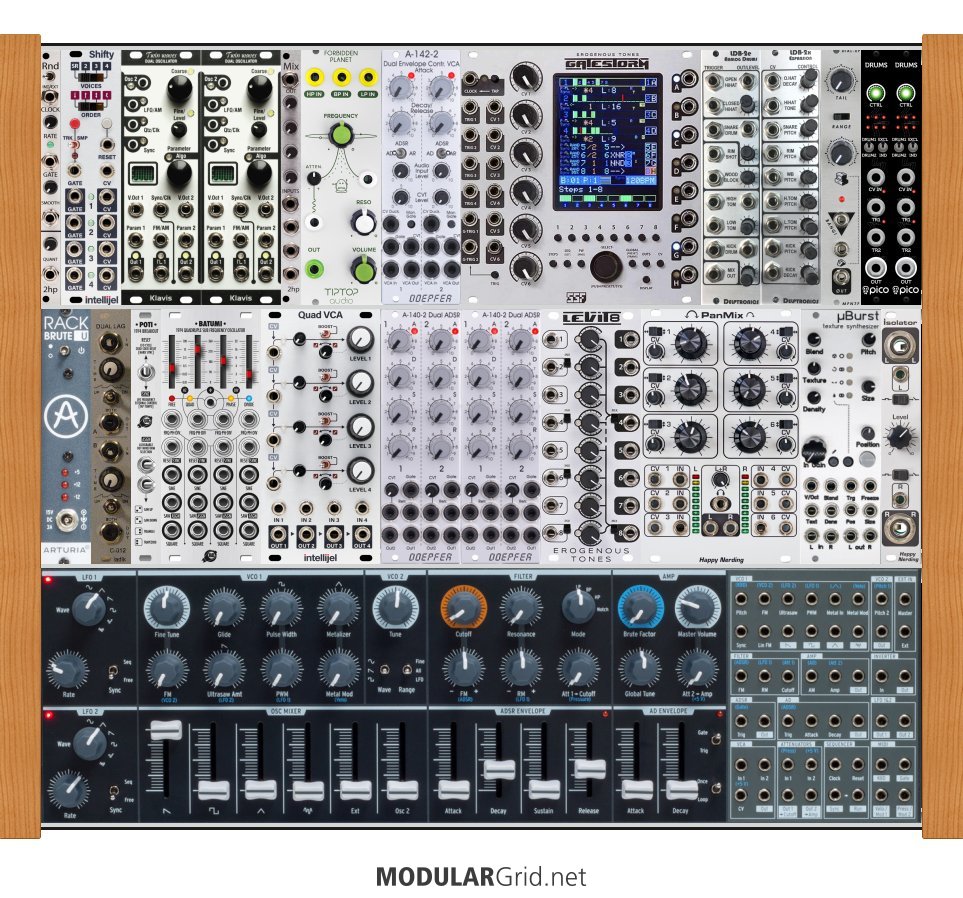First of all, the Minibrute 2 panel (which is lurking on here somewhere) was added so that you can keep its functions in mind as we look at the Rackbrute proper above. Top row is split between your 'voice' and 'drums'. A random CV source at left provides random fluctuating voltages for modulation use. Then a Shifty...this is a four-stage analog shift register/sample and hold which allows psuedo-polyphonic hocketing from a single incoming CV. Each time the module receives a clock pulse, it shifts the held CV to the next register. Then by connecting the registers to separate VCOs (of which there are four next to this, with internal quantizing), you get four-part rotating hocket/arpeggiation-type activity. Two Klavis Twin VCOs are next for four VCOs total. These are very complex oscillators with a lot of internal DSP control, which maximizes function within a tiny space. 4 -> 1 mixer allows you to sum these VCOs with variable levels, then this feeds to Tiptop's new Steiner Synthacon VCF clone. Great filter, lots of sonic possibilities, but still relatively simple and easy to control. Doepfer's new dual EG/VCA combo is last, which gives you an EG/VCA for your pre-VCF signal and one for post.
Drums: Gatestorm gate sequencer is the main pattern control/clock modulator/lots of other programmable things, with its clock incoming (more than likely) from the MB 2S. This generates eight gate patterns. The Delptronics modules to the right are based on the Roland 606 and 808 circuits, and next to that is the expander which allows some extra CV functions over the main drum sounds. A Moffenzeef module provides glitchy/fubar-type percussives, plus a pair of Erica Pico Drums gives you two channels of sampled drums. The drums can be submixed via part of the Levit8 below, and/or individual channels on the stereo mixer.
Bottom row is for modulation sources and mixing. Left side, next to the Power, is a dual lag generator, so that you can add in portamento functions for the voice section above (switchable between up, down, and up/down behaviors) or wherever else simple slew limiting might be useful. Batumi + Poti next; the Poti adds some extra control functionality to the Batumi that can be switched on the fly. Four VCAs after that, which can either function as a mixer or separately, and these can be adjusted for responses anywhere between linear (better for CV control) and exponential (which you more typically use for audio). Four ADSRs are after this. Then the mix section includes the Levit8 from before, a Happy Nerding 6 -> 1 stereo mixer with CV over level control, and then a shrunk-down third party build of the now-unavailable Clouds. This one is by Michigan Synth Works, available directly. A Happy Nerding Isolator at the end gives you a global stereo attenuator, converts synth to line level output, and has dual isolation transformers to help with noise/hum and to add a touch of transformer enharmonics.
All of this fits in the single 6U RackBrute. It costs much less (subtract the MB 2S's $649 from the total), draws less power, has ample internal clearance, and offers more functionality in less space. Now, as for the bass part...what I would suggest is a patchable device of some sort, and there's a few reasons why. First of all, if you want to put things under some level of computer control, it's smarter to have the bass and the MB 2S on two separate MIDI parts. Just makes more musical sense; you don't want everything doing the same exact thing, after all. Secondly, you're going to want to voice that rather differently for maximum 'punch', which also means you want its signal and level control very separate from everything else. Bass being as important as it is, it needs to be treated as its own thing in of itself. Last, you'll want to tweak it and operate it in general differently from the rest of the rig, also because bass is so significant. This means you're probably going to want something with its own internal sequencing or the ability to connect a basic sequencer to it, in addition to having the sound source itself separate, but you will still need to interconnect the clocking. This also means you'll be looking at a small portable stereo mixer to mix the MB 2S, the bass synth, and the stereo out from the RackBrute, plus anything you might add later on (laptop audio, another synth, etc). Very basic little setup, but effective.
As you can see, this is very different from "in the box"...you have to think of things as subunits, which are part of a larger whole, which then come together as a singular instrument, and then those form the whole rig. Inside software, much of the lower level of this process is already decided for you, which is one reason a lot of people jumping directly from solely using software to modular make a lot of critical errors. Now, this above version is A possibility. There are likely others, this one being something I cobbled up on the fly...but it will work very well for your purposes. However, before doing any refinements, study this example, understand how and why it works, then study other examples by experienced synthesists, historical instruments, the underlying concepts in analog synthesis and so on before making changes. And take your time...if you're building a musical instrument, you're building something which you should be using for quite some time. Given that, it should make lots of sense to take the time beforehand to get the most useful long-term result.


